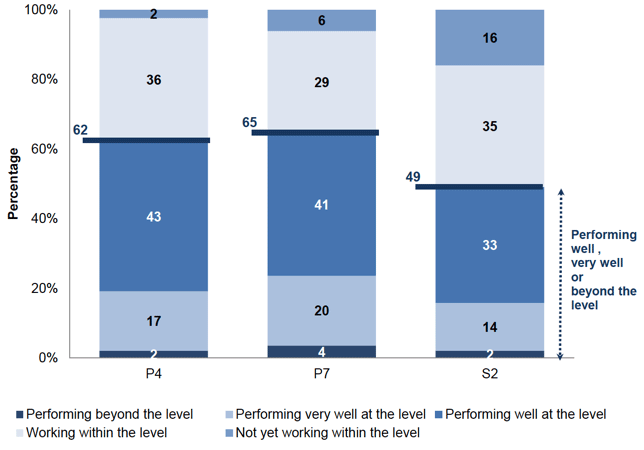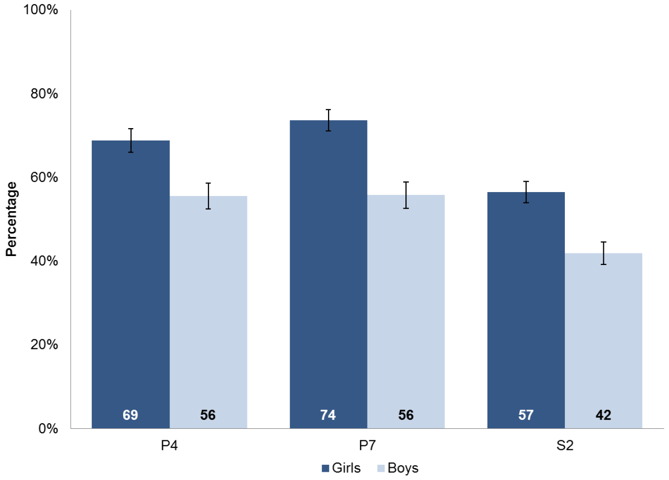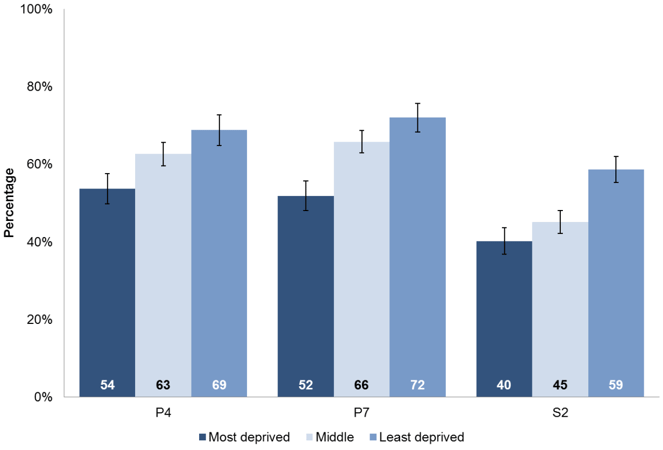Scottish Survey of Literacy and Numeracy 2016: literacy
Literacy results from the 2016 survey which covers assessment of school pupils at various stages in primary and secondary school.
Chapter 4: Writing attainment in 2016
- Writing performance was highest at P4 and P7 with over 60 per cent of scripts demonstrating pupils were performing well, very well or beyond the level.
- Girls outperformed boys in writing at all stages .
- Pupils from the least deprived areas performed better in writing than other pupils, across all stages .
4.1 Assessing writing skills
Half of participating schools were selected to take part in a writing assessment and were asked to submit two pieces of class-based writing for each sampled pupil. The two writing scripts for each pupil were from two different curriculum areas ( e.g. social subjects, science); written for two different purposes ( e.g. to describe an event, express an opinion); and were selected by teachers to reflect the level at which the pupil was currently working. Guidance on the selection of suitable writing pieces was provided to schools.
Each writing script was assessed by trained, independent assessors and marked according to the five reporting categories described in Table 1.1 (see Section 1.3). Around 110 Writing Assessors completed the ' SSLN Writing Assessor Programme' which was developed by SQA and was accredited with General Teaching Council for Scotland ( GTCS) Professional Recognition.
As each script is assessed independently, it is possible for each of a pupil's two scripts to be assigned to a different reporting category (for example, one script is assessed as performing well at the level and the other is assessed as performing beyond the level). As a result, the national performance is calculated at script level for writing ( i.e. the proportion of scripts within each of the five reporting categories). This differs from the national performance of reading and listening and talking, which are both calculated at pupil level.
4.2 Writing attainment
Writing performance in 2016 was similar in P4 and P7 where 62 per cent and 65 per cent of scripts, respectively, demonstrated that pupils were performing well, very well or beyond the level. It was lower for S2 at 49 per cent.
The percentage of scripts demonstrating that pupils were not yet working within the level was highest in S2 at 16 per cent. In P4 and P7 this was lower at six and two per cent respectively (Chart 4.1).
The experimental statistics publication 'Achievement of Curriculum for Excellence (CfE) Levels 2015/16' also presents a measure of writing performance for P4 and P7 pupils. For more information see Background Note 10.9. The results cannot be compared directly to the SSLN due to the differing methodologies and reporting styles, however, we can see similar writing performance of P7 pupils in both measures but differing performance at P4.
Chart 4.1: Performance in writing, by stage and reporting category

4.3 Attainment by gender
At all stages, the proportion of scripts that demonstrated girls' were performing well, very well or beyond the level was higher than boys' in 2016. The biggest difference in performance in 2016 was at P7 where it was 18 percentage points, whereas P4 had the smallest difference at 13 percentage points (Chart 4.3). This is different from reading attainment where there was no gender difference in P4 but girls outperformed boys in P7 and S2.
The pattern of writing attainment for boys was broadly similar to that for overall scripts for all stages i.e. attainment for boys was similar in P4 and P7 and lower in S2. For girls, there was a significant difference between P4 and P7 attainment that didn't exist for all pupils (P7 performance higher than P4).
Chart 4.2: Proportion of writing scripts demonstrating pupils performing well, very well or beyond the level, by gender and stage

At all stages, there were about twice as many girls' scripts assessed as beyond the level compared to boys. The group with the highest proportion of scripts demonstrating performance beyond the level was P7 girls at five per cent of scripts (two per cent for P7 boys).
Similarly, more than twice as many scripts from boys were assessed as being not yet within the level, compared to scripts submitted by girls, at all stages. At S2, the percentage of scripts from boys demonstrating that pupils were not yet working within the level was 21 per cent compared to ten per cent for girls.
There was evidence that girls outperformed boys at writing across all stages and by all measures (apart from P7, where there was no significant differences in the proportion of scripts assessed as performing well at the level: 43 per cent and 39 per cent for girls and boys respectively).
4.4 Attainment by deprivation
Writing scripts from least deprived pupils demonstrated evidence of higher attainment than those from most deprived pupils, at all stages in 2016.
Chart 4.3 shows the link between performance and deprivation. In all three stages pupils from the least deprived areas did better than those from the middle group who, in turn, did better than those from the most deprived areas. All the differences shown in the chart are statistically significant.
Chart 4.3: Proportion of writing scripts demonstrating pupils performing well, very well or beyond the level, by deprivation category and stage

The performance gap (the difference between the proportion of pupils from the least and most deprived areas performing well, very well or beyond the level) was largest for P7 at 20 percentage points, compared to 18 percentage points at S2 and 15 percentage points at P4.
Contact
Email: Marion MacRury
Phone: 0300 244 4000 – Central Enquiry Unit
The Scottish Government
St Andrew's House
Regent Road
Edinburgh
EH1 3DG
There is a problem
Thanks for your feedback